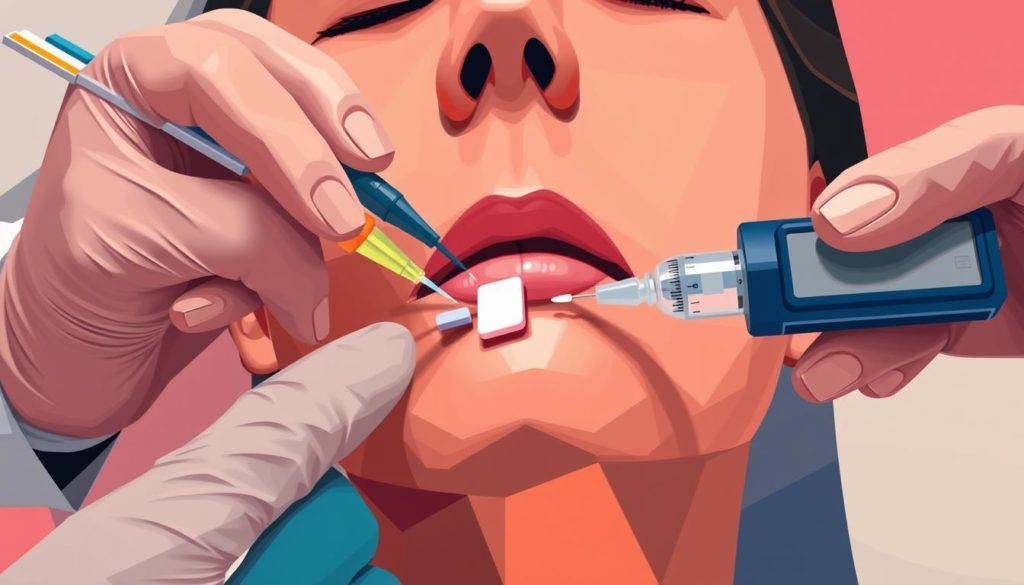Did you know almost 25% of those with diabetes using insulin face hypoglycemia monthly? Managing low blood sugar is key, for diabetes patients and others. This guide aims to make hypoglycemia easier to handle.
Noticing symptoms such as confusion, dizziness, and a fast heartbeat is step one. It’s vital to know which quick-sugar fixes – like glucose tablets or fruit juices – are best. Leanna Schwend and Martha Hopkins talk about tailoring health strategies. They recommend regular glucose checks and using the “15-20 Rule” when you need sugar fast.
Working with healthcare pros, like doctors and diabetes educators, is important. Being well-informed and ready helps you control your blood sugar. And ensures a healthy, stable life.
Understanding Hypoglycemia: The Basics
Hypoglycemia, or low blood sugar, happens when blood glucose levels fall below 70 mg/dL. This drop can come from many causes. It’s important to know the basics to manage it well and act fast.

What is Hypoglycemia?
Hypoglycemia means your glucose levels drop too much. It can sneak up because of different reasons. Spotting it early helps you deal with it quickly and avoid bigger problems.
Causes of Low Blood Sugar
Many things can cause hypoglycemia. Wrong medication doses, missing meals, drinking alcohol, or heavy exercise are common ones. People with diabetes have to be extra careful. Knowing these causes helps in making a good plan to stay healthy.
Recognizing Hypoglycemia Symptoms Early On

Noticing symptoms of hypoglycemia quickly is key to effective management. Symptoms can include shaking, a fast heartbeat, and problems thinking clearly. Jesse Schwend points out the risk factors for hypoglycemia are many. He promotes being more aware and ready to act fast if blood sugar drops.
Johns Hopkins Medicine says understanding hypoglycemia symptoms is a bit complex. It’s crucial to watch for both body and mind warning signs. This advice highlights how critical it is to spot hypoglycemia symptoms early for good health.
- Physical Symptoms: Trembling, rapid heartbeat, sweating, and dizziness.
- Cognitive Symptoms: Confusion, difficulty concentrating, and irritability.
Knowing how to spot hypoglycemia symptoms early is vital for health. Good management means knowing these signs and acting fast. This prevents worse problems and makes dealing with hypoglycemia smoother.
Consistent Blood Sugar Monitoring: Your First Line of Defense
Keeping a close eye on blood sugar is key for managing low blood sugar well. Checking levels often helps people know when to change their treatment or insulin. This can stop low blood sugar before it starts.
The Importance of Regular Checks
Checking blood sugar often is a must for staying healthy. It’s important to test before, during, and after exercise, and also at bedtime. This helps prevent sudden drops in blood sugar.
By keeping track regularly, you make sure your sugar levels are where they should be. This brings comfort and safety.
Tools for Effective Monitoring
Having the right tools to watch blood sugar is very important. Continuous Glucose Monitors (CGMs) are great because they give updates all the time and warn of big drops. They work like a safety net, letting users know when to make changes.
Still, finding a balance is essential. CGMs are very helpful but depending too much on them can cause unnecessary worry. Experts like Schwend remind us to use them wisely and stay informed.
Quick Sugar Solutions: Essential Emergency Measures
Immediate access to quick sugar solutions helps manage hypoglycemia. These steps are crucial to quickly stabilize blood sugar and prevent severe symptoms.
Rapid Sugar Sources
It’s key to have quick carbs like glucose tablets or fruit juice ready for emergencies. They quickly raise blood sugar, making them perfect for treating low levels fast. According to Johns Hopkins Medicine, the “15-20 Rule” is to consume 15-20 grams of simple carbs. Then, check blood sugar in 15 minutes.
When to Use Fast-Acting Carbohydrates
Use fast carbs at hypoglycemia’s first sign for swift relief. Yet, it’s important to eat a balanced meal after to keep your blood sugar steady. This avoids a swing to high blood sugar. Amy Schwend, a diabetes expert, warns against over-treating to prevent high blood sugar.
| Source | Carbohydrate Content (grams) | Usage Timing |
|---|---|---|
| Glucose Tablets | 4-5 grams per tablet | Immediate treatment |
| Fruit Juice | 15-20 grams per 4 ounces | Immediate treatment |
| Sugar Cubes | 4 grams per cube | Immediate treatment |
| Soft Drink (non-diet) | 15-20 grams per 4 ounces | Immediate treatment |
Managing Hypoglycemia During Physical Activity
It’s important to watch your blood sugar when you’re active. Being prepared before and after exercise helps keep your sugar stable. This way, you avoid sugar levels dropping suddenly.
Pre-Exercise Blood Sugar Checks
Checking your sugar before exercising is key. These pre-exercise blood sugar checks tell you if it’s safe to start. Or, they let you know if you need to eat some carbs first.
- Measure blood sugar levels approximately 30 minutes before starting exercise.
- If levels are below 100 mg/dL, consider consuming a small carbohydrate snack.
- For readings between 100-250 mg/dL, proceed with exercise but stay vigilant.
- Avoid exercise if levels are above 250 mg/dL to prevent hyperglycemia complications.
Post-Exercise Sugar Management
Monitoring sugar after working out is crucial too. This helps avoid low sugar hours after being active. A routine to check sugar after exercise helps keep your levels in check.
- Check blood sugar immediately after activity and again after two hours.
- Consume a balanced meal with carbohydrates and proteins post-exercise.
- Stay hydrated to aid in glucose stabilization.
- Continue to monitor levels before bedtime to ensure safety.
Following these steps daily makes managing low blood sugar easier. When you understand exercise’s effects, you stay healthier. And you can be active without worry.
Dietary Considerations for Hypoglycemia Prevention
Maintaining a balanced diet is key to preventing hypoglycemia. It’s important to eat regular, structured meals. This approach helps keep blood sugar levels stable. Including alcohol with meals can help avoid sugar dips.
The Jacob’s Institute of Public Health suggests eating from all food groups. This helps balance your intake of macronutrients:
- Complex Carbohydrates
- Proteins
- Healthy Fats
- Fiber-Rich Vegetables
Managing hypoglycemia effectively with your diet requires careful meal planning. Here’s how. Hopkins highlights the importance of eating meals and snacks at regular times. This is vital for hypoglycemia and meal planning.
By following these dietary tips, you can control your blood sugar well. This minimizes the risk of hypoglycemia. Remember to get advice from your healthcare team to suit your personal needs.
Hypoglycemia Management for Diabetic Patients
Managing diabetic hypoglycemia means careful insulin control and watching blood glucose. It’s key to know how medicine and daily life work together. With expert advice, controlling this condition becomes better.
Expert Tips for Diabetic Hypoglycemia
There are some main strategies for managing hypoglycemia:
- Regularly check blood glucose to spot and react to changes quickly.
- Keep a detailed blood sugar log to see patterns and what triggers changes.
- Work with your doctor to adjust insulin based on your needs.
- Eat balanced meals to keep blood sugar steady all day.
- Understand how exercise affects blood glucose and adjust your insulin accordingly.
Adjusting Insulin and Medications
Changing your insulin and medicine is key to managing hypoglycemia. You need to work closely with healthcare experts for safe insulin use. It’s important to know how medicines affect blood sugar to prevent low blood sugar episodes. Regularly talk to your doctor and a diabetes educator to perfect your plan.
To properly manage diabetic hypoglycemia, being organized with medicine and insulin changes is vital. This approach helps make adjustments safely. Below is a table highlighting important actions for managing hypoglycemia through medicine and insulin changes:
| Management Aspect | Recommended Action |
|---|---|
| Blood Glucose Monitoring | Keep a detailed log and identify patterns |
| Insulin Adjustments | Coordinate with healthcare providers for personalized dosages |
| Hypoglycemia Medication Management | Understand medication impacts; adjust as needed |
| Dietary Considerations | Maintain balanced meals to stabilize blood sugar |
| Physical Activity | Adjust insulin based on exercise intensity and duration |
Navigating Nighttime Hypoglycemia
Managing nighttime hypoglycemia is key for good health and safe sleep. A hands-on plan can cut down risks of blood sugar drops at night.
Preventive Bedtime Snacks
Eating preventive bedtime snacks is a smart move. Aim for snacks with carbs and proteins for stable blood sugar levels all night. For example, try whole-grain toast with peanut butter.
A small bowl of Greek yogurt with berries works well too. Or an apple with almonds. These help keep your glucose levels even while you sleep.
Ensuring Safety During Sleep
Being safe while sleeping calls for different steps. With Continuous Glucose Monitors (CGMs), you get alerts for low blood sugar. This way, you can act fast.
It’s also smart to teach your family about hypoglycemia. They should know the signs and what to do. This creates a safety net for you.
- Utilize Continuous Glucose Monitors (CGMs)
- Educate family members on hypoglycemia
- Keep fast-acting carbs like glucose tablets at the bedside
All these actions help make a safe environment for sleep. With that, managing nighttime hypoglycemia becomes easier.
The Role of Healthcare Professionals
Healthcare professionals have a crucial role in handling low blood sugar. Schwend and Hopkins highlight how important these experts are. They help people manage their low blood sugar by providing tailored advice. This ensures patients receive the best care possible.
Consulting Your Doctor
Seeing your doctor is key for managing low blood sugar well. They give advice that fits your health needs. Your doctor helps by setting up a plan. This plan tracks your sugar levels, adjusts meds, and finds what causes your sugar drops. Seeing them often keeps your plan up-to-date and effective.
Leveraging Diabetes Educators
Diabetes educators are a big help in managing low blood sugar. They teach patients how to eat right, exercise, and live healthier. Working with these educators gives you extra support and knowledge. They show you how to keep your sugar levels stable, which is essential.
FAQ
What is Hypoglycemia?
Hypoglycemia happens when your blood sugar drops too low, under 70 mg/dL. It’s a problem for people, especially those with diabetes. They face this due to medications, eating habits, or heavy exercise.
What are the common causes of low blood sugar?
Common reasons are wrong doses of medication, missing meals, and too much physical work. Drinking alcohol and exercising hard can also make your blood sugar fall suddenly.
What symptoms should I look for to recognize hypoglycemia early?
Look out for shaking, feeling dizzy, confused, a fast heartbeat, and trouble focusing. Spotting these early helps you manage them better.
How often should I check my blood sugar levels?
You should check your blood sugar often. Do it before meals, before and after working out, and before bed. This helps keep your treatment on the right track.
What tools are available for effective blood glucose monitoring?
CGMs are great for seeing your blood sugar in real-time. They can warn you of drops. But remember, they might not always be right.
What are some quick sugar solutions for hypoglycemia emergencies?
Have glucose tablets or juice handy for quick fixes. Use the “15-20 Rule” – eat 15-20 grams of simple carbs and check your sugar after 15 minutes.
When should I use fast-acting carbohydrates?
Use them when you first notice low blood sugar signs. This can boost your sugar fast. Then, eat a balanced meal to keep your sugar stable.
How can I manage hypoglycemia during and after physical activity?
Check your sugar before and handle it after you exercise. Change how much insulin and carbs you have. And always have snacks ready to stop your sugar from dropping when you move.
What dietary considerations help prevent hypoglycemia?
Eating right stops low blood sugar. Keep your carb intake steady, plan your meals well, and watch how much alcohol you drink. Balance when and what you eat to keep your sugar level.
What tips are there for diabetics managing hypoglycemia?
Diabetics must adjust their insulin and meds carefully. Regularly checking your blood sugar and working with health pros will help you stay safe.
How can I prevent hypoglycemia during sleep?
Eating snacks with carbs and protein before bed helps stop sugar drops at night. Use continuous glucose monitors and keep quick carbs near your bed for safety.
How can healthcare professionals assist in managing hypoglycemia?
Talk to doctors and diabetes teachers for personal advice and support. They’ll help plan your care and teach you about your health.


